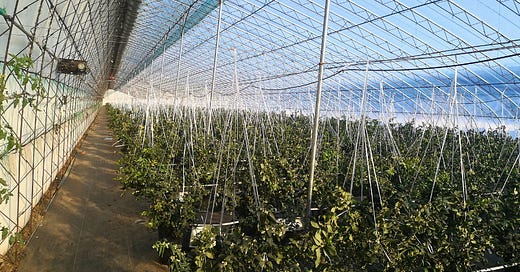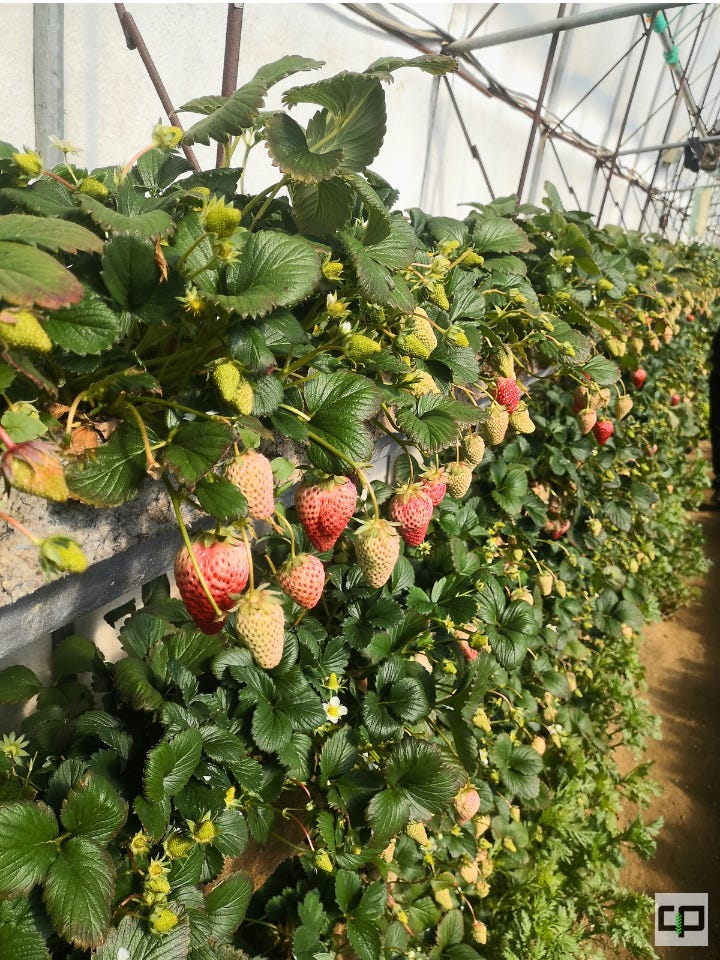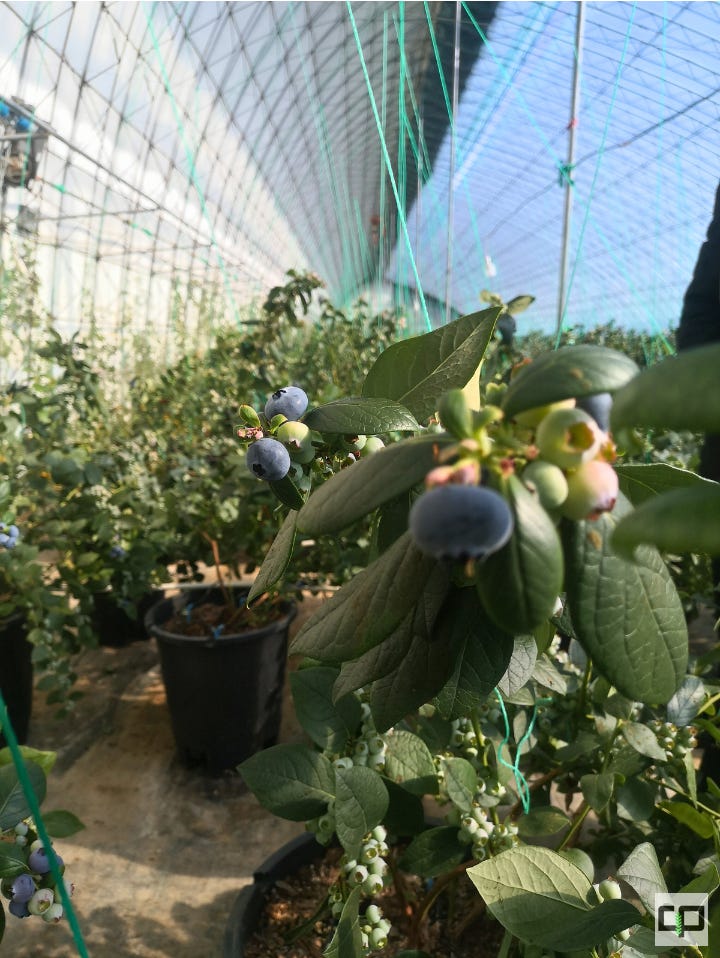field notes · Dandong's berry boom and uncertain futures
reflections on rural change, policy gaps, and agricultural anxieties in Liaoning
It’s been roasting recently in London, and I found my mind wandering back to Liaoning, as it often does.
I've been visiting a small city near Dandong for a decade now: my wife's hometown.
Since moving our base to the UK, our visits typically coincide with the festive atmosphere of Spring Festival, the bitter cold of late winter enveloping the region in snow, adding a more literal reflective quality to our trips.
But this year was different. I stayed longer, working, and arranged field visits before heading on to Inner Mongolia, Beijing, Shanghai, and beyond.
From past fieldwork experiences, I’ve found that such personal introductions work best. Guanxi indeed remains critical in China and, amid greater geopolitical rumblings, my pallid Scottish complexion now draws a little more attention than in the past.
Through my wife's stepfather—who served as a village chief for nearly two decades in one of the nearby counties—I connected with local stakeholders for a glimpse into rural livelihoods.
out in the fields
Despite festive warmth lingering from the holiday, the village felt subdued that crisp, cold Thursday. The roads were clear, but an underlying silence hinted at deeper demographic shifts. Polytunnel greenhouses (dapeng 大棚) radiated modest prosperity, more than matched by the warmth and kindness of locals, impossible to overstate.
The senior local official responsible for town administration appeared visibly nervous upon our arrival. My reassurances—emphasising I was there for ‘study’ (xuexi 学习), rather than ‘research’ (yanjiu 研究), given the connotations—and placing my phone in the car eased tensions, highlighting sensitivities surrounding local interactions.
Once settled, conversations flowed openly, so too with individual farmers, farm owners, and my ever-garrulous father-in-law.
berry boom
Large-scale greenhouse cultivation accelerated notably from May 2018, driven by government subsidies (~C¥4,000 per mu for farms over five mu).
Dandong strawberries, in particular the ‘Hongyan’ (红颜) variety, benefit from GI (Geographical Indication) status, linking them to the unique terroir of Liaoning’s fertile soils and temperate climate.
Yet, local producers face considerable market volatility, exacerbated by overproduction squeezing already tight margins. Recent seasons have seen dramatic price swings, notably during the winter-to-spring transition.
Premium-grade Dandong strawberries sold as luxury gifts at over C¥100 per jin (500g) over the 2024-5 winter, but later plunged, fuelling both economic and reputational anxiety.
During my February visit, blueberries fetched ~ C¥34 per jin, strawberries ~C¥22—still considerably higher than staple grains like corn, which hovered around just C¥2.10/jin.
counterfeit crisis
The popularity of Dandong strawberries has triggered widespread counterfeiting. A high-profile 2022 case involved a Jiangsu vendor falsely marketing local berries as premium ‘Dandong’ produce, exploiting substantial price gaps.
Such incidents undermine consumer confidence but also dilute the market value painstakingly built over decades.
Despite initiatives to enhance GI enforcement, introduce traceability measures, and deploy specialised strawberry insurance programs, growers remain cautious, reflecting limited tangible benefits so far.
Southern competition
Competitively, Dandong’s strawberry industry faces threats from southern provinces (like Yunnan and Guangdong), which benefit from milder winters, lower production costs, and advanced agricultural technologies such as hydroponic vertical farming or automated climate control systems.
Although unable to fully replicate Dandong’s terroir-driven quality, these regions offer stable pricing and year-round availability, intensifying competitive pressures.
As a result, some Dandong growers switched from strawberries to blueberries, reflecting broader uncertainty about their long-term viability amid intensifying competition.
Despite attempts at diversification, agriculture remains the area’s economic backbone.
Strawberries and blueberries still lead the way, supplemented by smaller-scale livestock (mostly pigs and chickens), oyster mushrooms, ginseng, chestnuts, and aquaculture—primarily for personal consumption.
Yet struggles within the agricultural sector amplify broader uncertainties.
comfort today, questions tomorrow
Earlier infrastructure investment—improving roads, electricity, water supply, and internet access—are still evident and appreciated.
Many homes are renovated or expanded, and residents proudly described their upgraded clothing and daily comforts, summarised neatly by the Northeastern dialect phrase ‘杠杠滴’ (ganggang di, roughly ‘top-notch’).
And indeed, they do live well: despite tight margins from cash crops, the homestead set-up (with personal cultivation and livestock), ensures good day-to-day quality of life.
Yet immediate quality-of-life gains contrast starkly with long-term uncertainty, as demographic pressures intensify questions about future viability.
Rural revitalisation efforts post-COVID disappointed locals, failing to deliver tangible economic benefits. Agricultural volatility has compounded economic stagnation, intensifying pressure on local livelihoods.
Young residents continue migrating to cities like Shenyang and Qingdao, drawn by better prospects.
"It would take more than money", remarked one farmer, capturing a deeper issue: financial incentives alone won’t reverse outward migration if prospects remain uncertain and unstable.
limited markets
Strawberries and blueberries from the region predominantly serve domestic markets, with no immediate export plans mentioned despite the premium reputation of Dandong strawberries.
While the regional government heavily promotes the brand through media and official discourse, growers consistently stressed that genuine economic backing, beyond mere publicity, has been conspicuously absent.
Farmers have limited engagement with e-commerce (~2 percent of total sales), primarily due to prohibitively high cold-chain logistics costs eroding thin margins. Ambitious initiatives, such as SF Express’s ‘strawberry special planes,’ have yet to noticeably benefit local growers, dampening enthusiasm for online markets.
Daily realities of high transport fees and logistical complexities further discourage more aggressive pursuit of e-commerce.
collective cynicism
Although local cooperatives and industry associations exist, stakeholders described these institutions dismissively—as existing largely in name only, functioning more as subsidy conduits rather than genuine advocates for growers.
This extends to policy measures like the Rural Collective Economic Organisations Law (effective 1 June 2025) is designed to empower.
My then-optimism on the Law’s intended outcomes was tempered by the widespread cynicism, highlighting a gap between policy intentions and lived experience.
Although Liaoning authorities prioritise Dandong strawberries under their ‘One County, One Industry’ strategy, incentivising quality-based marketing and introducing financial tools like ‘Fresh Fruit e-loans’ and innovative insurance programs, tangible benefits are not felt by smaller-scale farmers.
Bridging the gap between ambitious policy and on-the-ground realities remains essential for the region's sustainable future.
modest mechanisation
Mechanisation in the region remains underdeveloped, particularly compared to more advanced agricultural regions in southern China.
The polytunnel greenhouses (dapeng, 大棚) visible throughout the village are effective but notably labour-intensive, with daily agronomic tasks still predominantly manual.


While drone technology for spraying pesticides is present locally, its use remains limited and largely dependent on individual investments rather than collective or government-led initiatives.
Smart agriculture initiatives—e.g. automated greenhouses, sensors, or IoT-driven monitoring systems—have yet to take root here, reflecting broader scepticism about their practical benefits amid significant upfront costs.
Local agricultural production overall remains largely individual or family-based, with minimal shifts towards cooperative or corporate models of farming.
During our visit, my FiL noted spacing differences between blueberry plants at different farms, suggesting uneven adoption of updated agronomic practices
Some growers expressed frustration at the lack of direct technical training or substantial financial support to sustainably enhance productivity.
This absence of practical backing leaves substantial untapped potential for boosting productivity through modernisation, training, and technical knowledge dissemination.
uncertain futures
Perhaps most striking was the local official’s uncertainty regarding the town’s future—a sentiment broadly echoed. Without a clear long-term strategy or viable economic growth paths, local uncertainty intensifies. This compounds demographic pressures: without realistic pathways for young residents, the village’s viability remains precarious.
Ultimately, the renowned berry industry symbolises local strengths and vulnerabilities alike.
The choices made over the next decade will shape the region’s agricultural future. It may well serve as a telling microcosm of rural China’s broader transformation beyond wealthier, more celebrated areas.
When I asked what would happen if local decline continued (the town's population has halved in recent decades), a farmer’s reply was stark: “没人就不是个镇儿” (mei ren jiu bu shi ge zhen’r), “If there are no people, there’s no town.”
Let’s hope it doesn’t come to that.









Thanks--such honest on-the-ground observations are rare--and the local peoples' nervousness shows why. A lot of interesting threads to pull on...
I notice the strawberries are started in trays, grown inside plastic tunnels with climate control year-round. I wouldn't be surprised if there's a local Dandong company growing strawberries in full-on artificial conditions in glass greenhouses with all the sensors and automated climate/humidity control as well. So, in what sense is this really a GI/terroir crop with features unique to the locality? Do Dandong berries really have attributes distinguishing them from the counterfeiters? The Chinese consumer has never been fully sure of what they're getting, so price premiums are hard to sustain.